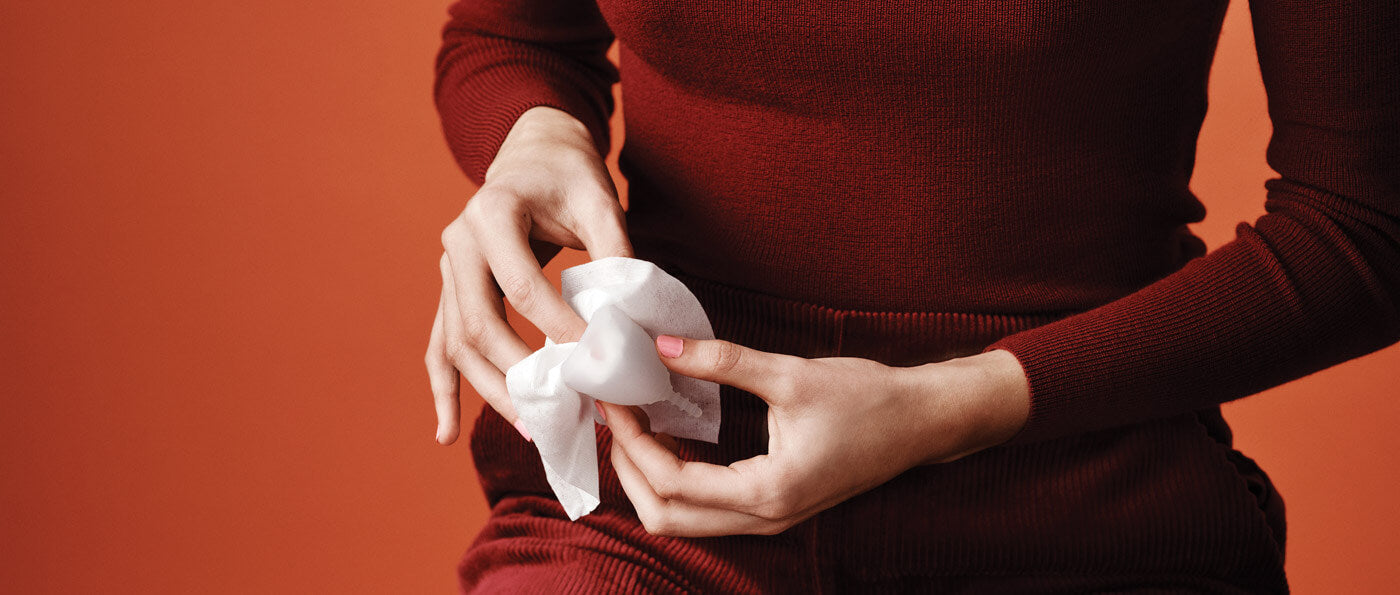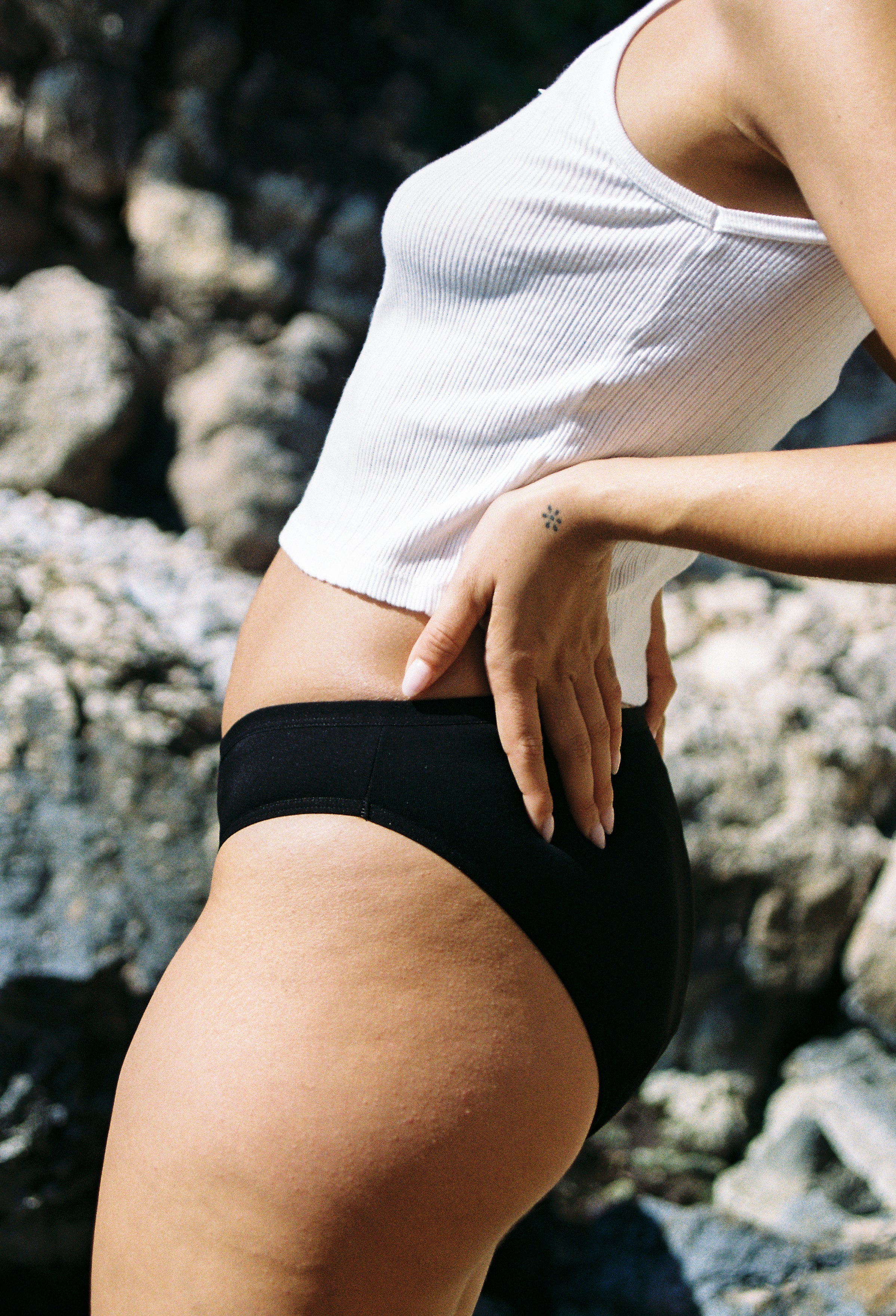Cuando comienzas a usar una copa menstrual, es importante saber cómo limpiarla, cuánto tiempo hervirla y cómo almacenarla y desinfectarla de manera efectiva. Puede resultar difícil saber qué jabones o soluciones de limpieza son seguros, cómo quitar las manchas de la copa menstrual y cuándo debes reemplazarla. ¡Estamos aquí para responder todas tus preguntas y ayudarte a que tu transición a las copas menstruales sea fácil e indolora!
¿Qué es una copa menstrual?
Una copa menstrual es un producto menstrual sostenible y reutilizable que generalmente está hecho de silicona de grado médico o TPE (termoplástico) y no contiene productos químicos nocivos ni BPA (bisfenol A). Son una alternativa de tampón flexible y fácil de usar que te durará años. Son tan seguros y eficaces para detener fugas como los tampones .
Los nuestros están hechos de silicona de grado médico y son incoloros para evitar el uso de aditivos de color. Se pueden usar hasta por 12 horas seguidas y son cómodos, seguros y ¡una mejor opción para tu cuerpo y el planeta!
Entonces acabas de comprar una copa menstrual, ¿y ahora qué?
Deberá hervir su copa menstrual antes de usarla por primera vez. Esto es para desinfectar el producto, de modo que su taza sea segura de usar cuando esté listo para comenzar a usarla.
Necesitarás algunas cosas:
- maceta
- cocina
- agua
- batir (opcional)
Después de lavarse las manos, revise la copa menstrual para asegurarse de que los orificios de ventilación en la parte superior estén abiertos y no bloqueados. Luego, toma un recipiente que sea lo suficientemente grande como para contener (y sumergir completamente) la copa menstrual. Llena la olla con agua y luego déjala hervir. Coloca la taza en el agua hirviendo, asegurándote de que esté completamente sumergida. Luego simplemente déjalo hervir de 3 a 5 minutos, vigilando la taza para asegurarte de que no se queme y permanezca debajo del agua.
Un consejo que puedes utilizar es poner tu taza dentro de un batidor de varillas para evitar que entre en contacto con el fondo de la olla, pero esto no es necesario.
¿Cuánto tiempo debes hervir tu copa menstrual?
Hervir la copa menstrual es un método de esterilización rápido y eficaz. Una pregunta común es cuánto tiempo debe durar el proceso de ebullición. Para una limpieza óptima, lo mejor es dejar hervir la taza durante al menos 3 a 5 minutos. Mantener la taza sumergida en agua hirviendo durante este tiempo es crucial para eliminar cualquier bacteria o microorganismo.
¿Tienes que hervir tu copa menstrual cada vez?
Es fundamental hervir la copa menstrual antes del primer uso. Después de eso, tienes opciones. Puedes hervir la copa entre ciclos o, si lo prefieres, simplemente puedes lavarla con un limpiador de copa menstrual o un jabón suave, sin perfume y sin aceite. No es estrictamente necesario hervir cada vez, pero se recomienda para una esterilización completa.
Qué usar para limpiar tu copa menstrual
Tocamos muchas cosas a lo largo del día, desde barandillas de escaleras, teclados, teléfonos, manijas de puertas, etc.; asegurarse de lavarse las manos puede prevenir infecciones. Lávese siempre las manos con jabón suave y agua tibia antes y después de manipular su taza.
Afortunadamente, no es mucho trabajo limpiar la copa entre usos, pero existen algunos productos de limpieza que debes evitar para prevenir infecciones, reacciones o sensaciones incómodas como ardor o picazón. Ya sea que esté acampando, en la ciudad o en casa, puede cuidar su taza de forma fácil y segura sin preocupaciones.
¿Qué está bien?
Hay bastantes opciones que puedes probar al limpiar tu taza para ver cuál funciona mejor para ti. Deberías utilizar productos como un limpiador menstrual exclusivo, como nuestro limpiador de copas , que tiene un pH equilibrado y está diseñado para no tener fragancia y no causar irritación. Cualquier otro jabón suave, sin perfume y sin aceite también puede hacer el trabajo de forma segura.
Que evitar
Su vagina se limpia sola y puede ser sensible a sustancias duras o desconocidas, por lo que es importante utilizar productos que sean suaves y delicados al limpiar su copa menstrual. Debes evitar cosas como:
- Peróxido de hidrógeno
- Lejía
- Bicarbonato
- Detergentes y jabones para ropa o lavavajillas
- Jabones con fragancia
- jabones a base de aceite
- alcohol isopropílico
- Vinagre
Limpieza diaria durante tu período.
Dependiendo de tu flujo y del tamaño de tu copa menstrual, podrás usarlas hasta 12 horas seguidas y solo tendrás que lavarlas hasta dos veces al día. Es esencial limpiar la taza porque ayuda a eliminar las bacterias, disminuye la acumulación y ayuda a prevenir manchas y olores.
Durante su período:
- quitar la taza
- Vaciar sangre en el inodoro.
- Enjuague la taza con agua fría
- ¡Ahora estás listo para volver a insertar la copa!
Cómo lavar tu copa menstrual cuando estás fuera de casa
Si vas a utilizar baños públicos, ir de campamento o estar en algún otro lugar sin acceso a agua corriente, también puedes usar toallitas especialmente diseñadas para limpiar tu copa menstrual. Simplemente vacía la copa como de costumbre y usa una toallita para copa menstrual para limpiarla y luego vuelve a insertarla y desinfecta tus manos nuevamente. Si no tienes toallitas, puedes usar papel higiénico; solo asegúrese de quitar todo el tejido antes de reinsertarlo. Luego, tan pronto como estés en casa, asegúrate de limpiar tu copa menstrual como de costumbre.
Cuando acampe o pase días sin acceso a agua corriente, vierta el flujo en un pequeño agujero en el suelo (como lo haría con los desechos orgánicos normales), use agua embotellada para enjuagar su taza, séquela con un pañuelo limpio y luego vuelva a insertarla. Cuando viaje con su taza, asegúrese de guardarla en su bolsa para mantenerla limpia.
Desinfección entre períodos
Cuando termine tu período necesitas desinfectar tu copa menstrual. La forma más efectiva es hervir tu copa menstrual tal como lo hacías antes de comenzar a usarla. Puedes optar por hervirlo en la estufa o incluso utilizar un recipiente especial. Se recomienda hervirlo de 3 a 5 minutos y luego estará listo para almacenarse hasta su próximo ciclo.
Cómo guardar tu copa menstrual
La mayoría de las copas menstruales vienen con una bolsa de algodón transpirable y la nuestra está hecha de algodón orgánico. Es importante que nunca guardes tu taza en una bolsa de plástico o en un recipiente hermético, ya que esto podría ser un caldo de cultivo para las bacterias.
Hablemos de esos 'y si'
Qué hacer si se te cae la copa menstrual en el inodoro
Si su copa menstrual se cae al inodoro, absténgase de usarla inmediatamente. El mejor curso de acción es hervir bien la taza para asegurarse de que esté desinfectada. Este incidente puede parecer alarmante, pero un proceso de esterilización adecuado hará que la copa sea segura para su uso nuevamente.
¿Qué pasa si mi copa menstrual se mancha?
Es probable que se produzcan manchas y decoloración. Si su copa menstrual está manchada, no significa que esté sucia o que necesite ser reemplazada. No hay ninguna razón para intentar quitar las manchas a menos que sea por motivos estéticos. Puedes quitar las manchas dejando la taza expuesta a la luz solar directa durante 24 horas.
¿Qué pasa si mi taza tiene olor?
El mantenimiento y la limpieza regulares pueden ayudar a combatir los olores de su copa menstrual, pero también puede dejarla expuesta a la luz solar directa para eliminar los olores.
Cuándo reemplazar tu taza
Debe reemplazar su taza si hay signos de agrietamiento, división o rotura, si su taza tiene un residuo calcáreo o se vuelve pegajosa al tacto. La decoloración extrema, el adelgazamiento y el mal olor que no se pueden eliminar son una señal de que también es hora de comprar una taza nueva. Tienen una vida útil relativamente larga y, por lo general, no es necesario reemplazarlos durante 2 o 3 años.
Un período más seguro y más fácil
Mantener tu copa menstrual limpia y desinfectada es importante para tu bienestar general. Siempre que limpies tu copa y sigas las recomendaciones de higienización y mantenimiento, tu copa te durará años y además te ahorrará gastar mucho dinero en otros productos para la menstruación cada mes.
Una nota final: si en algún momento desarrollas algún tipo de infección que pueda estar relacionada con tu copa menstrual, deja de usarla inmediatamente y contacta con tu médico.
Preguntas frecuentes (FAQ)
¿Cómo hervir una copa menstrual?
Hervir una copa menstrual es un proceso sencillo. Después de lavarse las manos, revise la copa menstrual para asegurarse de que los orificios de ventilación en la parte superior estén abiertos y no bloqueados. Luego, toma un recipiente que sea lo suficientemente grande como para contener (y sumergir completamente) la copa menstrual. Llena la olla con agua y luego déjala hervir. Coloca la taza en el agua hirviendo, asegurándote de que esté completamente sumergida. Luego simplemente déjalo hervir de 3 a 5 minutos, vigilando la taza para asegurarte de que no se queme y permanezca debajo del agua.
¿Qué debo hacer si se me cae una copa menstrual al inodoro?
Si tu copa menstrual se cae al inodoro, ¡no la vuelvas a insertar! En su lugar, asegúrese de hervir la taza para desinfectarla completamente antes de volver a usarla. Los accidentes ocurren, pero es importante asegurarse de que su copa esté limpia y sea segura de usar antes de volver a insertarla.
¿Cómo guardar una copa menstrual?
La mayoría de las copas menstruales vienen con una bolsa de algodón transpirable para guardarlas. Es importante que nunca guardes tu taza en una bolsa de plástico o en un recipiente hermético, ya que esto podría crear un caldo de cultivo para las bacterias. Asegúrese siempre de que su copa menstrual esté completamente seca antes de guardarla.
¿Con qué frecuencia debo reemplazar mi copa menstrual?
Con los cuidados adecuados, una copa menstrual puede durar varios años. Sin embargo, se recomienda reemplazar la taza si hay signos de agrietamiento, división o rotura, si la taza tiene un residuo calcáreo o se vuelve pegajosa al tacto. La decoloración extrema, el adelgazamiento y el mal olor que no se puede eliminar también son señales de que es hora de comprar una taza nueva.
¿Puede la copa menstrual provocar infecciones?
Las copas menstruales son generalmente muy seguras de usar. Sin embargo, como cualquier otro producto para la menstruación, es necesario utilizarlos y limpiarlos adecuadamente para prevenir infecciones. Si en algún momento desarrollas algún tipo de infección que pueda estar relacionada con tu copa menstrual, deja de usarla inmediatamente y contacta con tu médico.
¿Puede una copa menstrual provocar olores?
El mantenimiento y la limpieza regulares pueden ayudar a combatir los olores de su copa menstrual. Sin embargo, si su taza desarrolla un olor persistente, puede ser una señal de que es necesario reemplazarla.
¿Cómo puedo quitar las manchas de mi copa menstrual?
Las manchas y la decoloración son normales y no necesariamente significan que la taza esté sucia. Sin embargo, si deseas eliminar las manchas, puedes dejar la taza expuesta a la luz solar directa durante 24 horas. A menudo, esto puede ayudar a aclarar las manchas y eliminar los olores.
En conclusión, mantener una copa menstrual puede parecer desalentador al principio, pero con algunas rutinas y cuidados simples, puedes asegurarte de que tu copa menstrual permanezca limpia, segura y lista para usar en los años venideros. Al elegir una copa menstrual, no sólo estás tomando una decisión sostenible y rentable, sino que también estás dando un paso hacia un período más seguro y más fácil. Recuerde, si en algún momento experimenta algún problema o molestia, no dude en consultar a su proveedor de atención médica.






